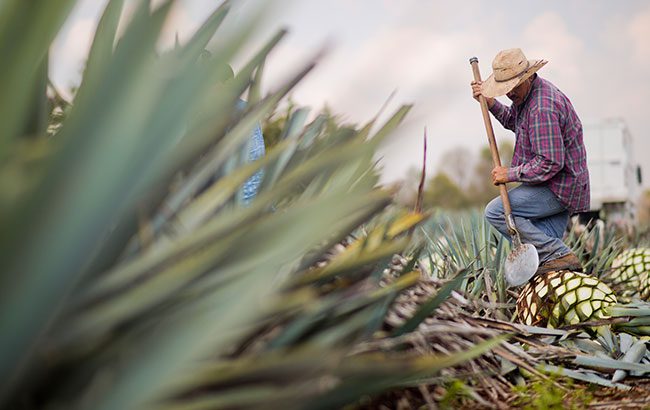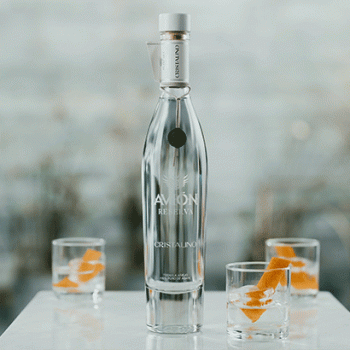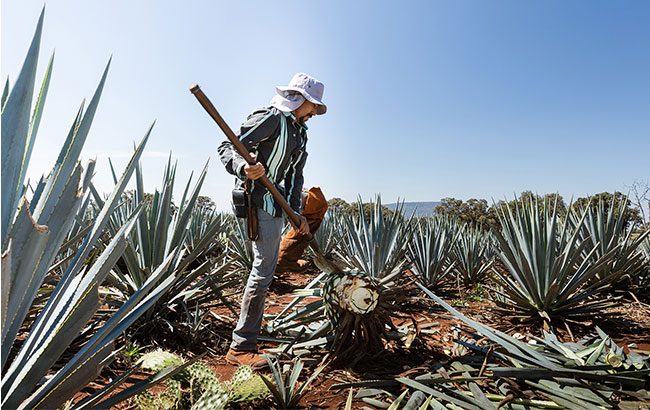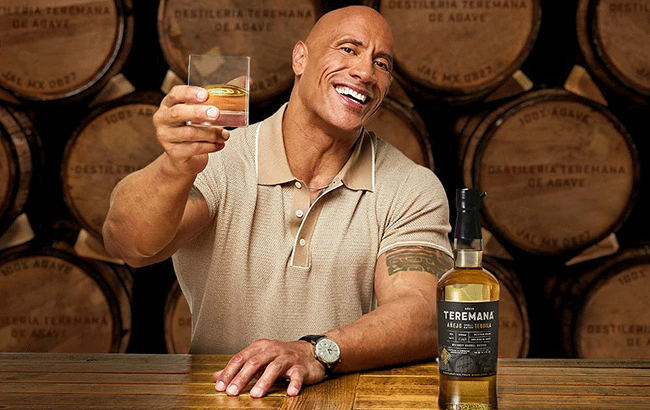What’s behind the Tequila boom?
Demand for Tequila is soaring – but rapid growth has created challenges for the category, as Tom Bruce-Gardyne reports.

*This feature was originally published in the February 2022 issue of The Spirits Business magazine.
“It’s insane, isn’t it?” says Jenna Fagnan, laughing in disbelief at the current explosive growth in Tequila.
Having co-launched Avión in 2010, and co-founded Teremana with Dwayne ‘The Rock’ Johnson 10 years later, Fagnan has witnessed the explosion from within. She claims her business partner, Ken Austin, spotted the trend 15 years ago when “Patrón was probably the only large brand in the premium and super-premium space at the time”, she says. “And it’s funny because he spoke to every multinational and they said ‘You’re crazy! No one’s going to be drinking that. That’s not the future’.”
Well, they got that one wrong, at least in the US, where super-premium Tequilas – which include Patrón, Herradura and Don Julio – have gone from selling just 665,000 cases in 2005 to 5.1 million in 2020, according to the Distilled Spirits Council of the US (Discus). This growth, together with the booming ‘high-end premium’ sector, whose sales hit 3.2m cases last year, has driven the category. By 2020, total Tequila in the US had doubled to 22.2m cases since 2010, and last year volumes rose by a further 5%, with value up by 16.1%, according to Nielsen IQ.

“We were a bit worried at the beginning,” says Michael Merolli, head of Pernod Ricard’s House of Tequila, about the impact of the Covid-19 pandemic on the category. “We thought we’d lose a lot of consumption, but actually people were still willing to unwind and relax, and people were learning how to make cocktails at home.”
If on-trade margins act as a brake on consumption and trading up, there are fewer constraints in retail and e-commerce, where US consumers have been buying top-end Tequilas like never before. In its Luxury Brands Index, which tracks spirits that retail for US$50 or more, Discus reported Tequila was up by 83% in the year to September 2021, followed by American whiskey and Cognac, at around 38% each.
Delving deeper into the trend, Fagnan sees a generational switch. “Younger consumers didn’t have the baggage that older consumers had about bad Tequila,” she says. “They had access to a lot of smaller, niche players. The Tequila was delicious, it was about the agave, and they felt fine the next day.”
Here, she is talking of quality 100% agave Tequila, rather than mixto Tequila. The traditional baptism into the drink involved a night of shots, followed by a morning vowing never to touch the spirit again.
In the UK it remains an unwritten rule to mention the above cliché in any article about Tequila, but that’s less common in the US, and for Fagnan that “tells you the gap between where the US is and where the rest of the world is”.
Mia Simpson Culp, managing director global Tequilas at Brown-Forman, says: “The entrypoint might still be a mixto, but people are quick to graduate to 100% agave Tequila, and I don’t think there’s a lot of return. In my mind there’s such a clear quality difference.”
Chris Moran, CEO and founder of Ghost Tequila, says those new to the category are undoubtedly going straight for 100% agave brands like his, which is presumably why some mixtos hide their ‘mixto’ credentials.
In its latest half-year results to December 2021, Brown-Forman’s pair of 100% agave Tequilas posted strong growth. Global underlying net sales for Herradura were up by 46%, while El Jimador grew by 19%. But clearly this all has an impact in Mexico.
Culp calls it: “The other side of the coin for a category where consumer demand is so healthy, is it naturally leads to higher input costs. Agave prices are high but still below the peak. I think the external price is now 27 pesos (US$1.42) a kilo, and I believe the high in the last five years was in the low 30s.”
It takes around seven kilos to make a litre of 100% agave Tequila. Last August, Guillermo Erickson Sauza, of Tequila Fortaleza, told tastetequila.com: “Our number one cost is still agave. Ten years ago, it cost us about US$1,875 to fill our small (15-ton) oven. Now it costs US$22,500.” Add in the surging costs in energy and dry goods, and Moran says: “I think we’re going to see some drastic price increases coming from some brands this first quarter.”
Many producers struggled to source glass bottles, cardboard, pallets and other equipment, and “almost every major brand of Tequila has been out of stock for at least one of the last six months in the UK,” claims Jesse Estes, Tequila Ocho’s brand ambassador. Like many, he’s had to sell on allocation, and says: “We’re not taking on new markets because we are trying to control our growth.”

Growing pains
While describing the current situation as “growing pains in the short-to-medium term”, Estes remains positive about the industry’s future. Rashidi Hodari, managing director of Beam Suntory’s Tequila brand house, says: “The biggest worry would be that folks aren’t taking a long-term view, and with so many people thinking they’re going to make some money in the short term, a bubble will happen.”
However, he believes established players like Beam Suntory, whose Tequilas include Sauza, El Tesoro and Hornitos, will mitigate that risk, along with those invested in the drink’s supply chain.
In October, Diageo announced it would invest US$500m in new production facilities in Jalisco, Mexico, following a reported 79% jump in organic net sales of its Tequilas in its full-year 2021 results. Having tried and failed to acquire José Cuervo in the past, its decision to go up market and buy Don Julio in 2015, and Casamigos two years later, has certainly paid dividends.
Estes sees Diageo’s latest move as a great example of “investing a great deal in infrastructure to support future growth”. And Tequila Ocho has a new distillery that opened last autumn in time for the current boom.
“We also have a big plan of investment,” adds Pernod Ricard’s Merolli, saying: “We’re investing in our production capacity and we’re also investing in agave, which we’ve been planting. And we’re investing behind our brands.” He concedes that Pernod has been “quite marginal” in the category, “except with Olmeca mixto Tequila, which is quite big in some big markets, like Russia where we’re the leader.” In 2018, the company plugged a gap in its portfolio by acquiring full control of super-premium Avión Tequila, a year after acquiring a majority stake in Del Maguey mezcal.
As the leading export brand, Del Maguey is enjoying triple-digit growth, according to Merolli, who says the supply issues are “even more challenging on mezcal”. He believes the category, which represents the “artisan, craft” side of agave, won’t cannibalise Tequila, and says: “It’s complimentary.”
Brown-Forman’s Culp feels the same, and reckons mezcal plays a similar role to rye in the American whiskey category.
As to what lies behind the US Tequila boom, she mentions “the perceived health and wellbeing” aspect of being a plant-based spirit, as well as the drink’s famous mixability.
“The Margarita is such a popular serve and so easy to make at home,” she says. “And the great thing about the Margarita is there’s not only one recipe,” adds Merolli. “There’s also the fact that Mexico’s quite hot, culturally speaking. People are discovering that it’s a very diverse country, thinking about art, design, movies and gastronomy.”
And then there is Hollywood, where just about everyone has been jumping on the Tequila bus. “It’s becoming crazy,” says Merolli. “There isn’t a week without a new celebrity announcing they’re doing a Tequila. It’s probably too much, and probably a bit late for some.”

But Estes believes tie-ins like George Clooney’s Casamigos and Dwayne Johnson’s Teremana have been positive. “I think it’s just brought Tequila into the mainstream,” he says. “Maybe people who drank Tequila 20 years ago and had a bad experience and swore off it, are saying: ‘There must be more to this that I’ve missed’.”
Hodari feels American consumers are reappraising the drink as they discover 100% agave Tequilas like Hornitos positioned as an entry-point brand. “Twenty years ago, shots were just about ‘give me something cheap, I don’t want to taste’,” he says. “Now people want their night out to be memorable, and not something that’s forgettable.”
For all the buzz around Tequila in the US and Mexico, Hodari accepts the reappraisal job has yet to happen elsewhere. “I’ve seen the amount of work that my counterparts have put in with Bourbon to globalise the brands, and it’s not going to happen for Tequila without similar effort,” he says.
Fagnan is puzzled by this delayed take-off “because we live in such a global world”, she says: “But I do think that post-pandemic it’s going to change, and change quickly.”
Now, Tequila accounts for just 0.5% of UK spirits by volume, according to IWSR Drinks Market Analysis, which predicts a compound annual growth rate of 4.6% globally until 2025. Watch this space.
Related news
Cocktail stories: Speed Bump, Byrdi
